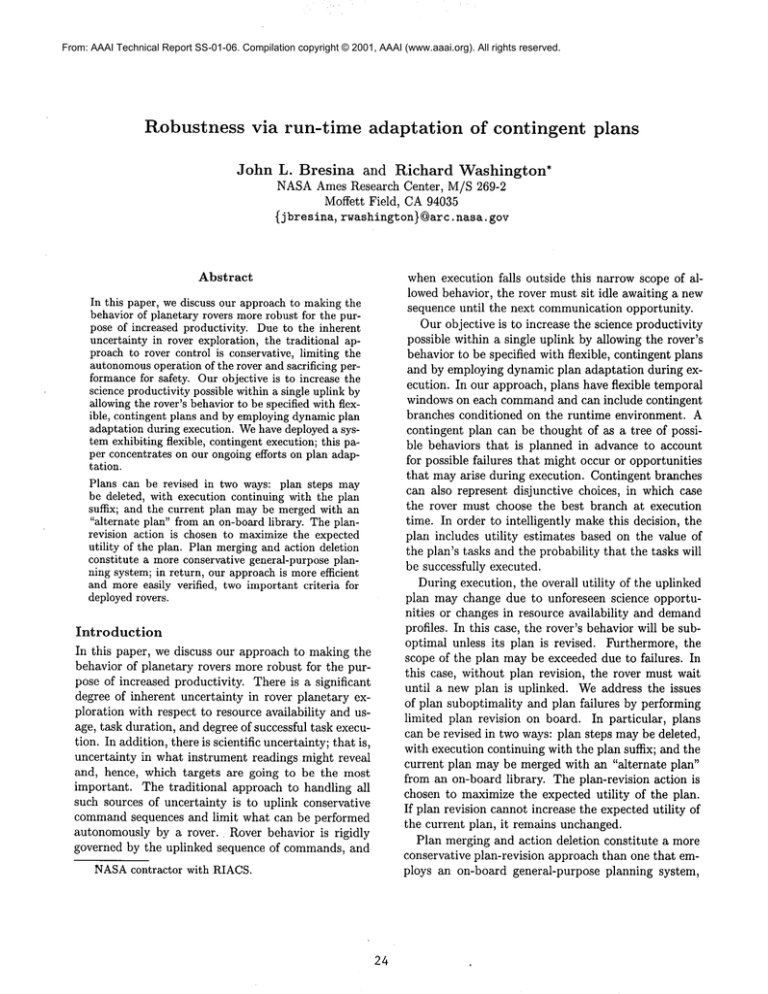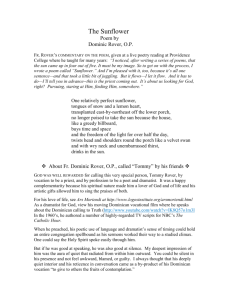
From: AAAI Technical Report SS-01-06. Compilation copyright © 2001, AAAI (www.aaai.org). All rights reserved.
Robustness via run-time adaptation
John
plans
L. Bresina
and Richard
Washington*
NASAAmes Research Center, M/S 269-2
Moffett Field, CA94035
{jbresina,
rwashington)@arc
.nasa.gov
Abstract
when execution falls outside this narrow scope of allowed behavior, the rover must sit idle awaiting a new
sequence until the next communication opportunity.
Our objective is to increase the science productivity
possible within a single uplink by allowing the rover’s
behavior to be specified with flexible, contingent plans
and by employing dynamic plan adaptation during execution. In our approach, plans have flexible temporal
windows on each commandand can include contingent
branches conditioned on the runtime environment. A
contingent plan can be thought of as a tree of possible behaviors that is planned in advance to account
for possible failures that might occur or opportunities
that may arise during execution. Contingent branches
can also represent disjunctive choices, in which case
the rover must choose the best branch at execution
time. In order to intelligently makethis decision, the
plan includes utility estimates based on the value of
the plan’s tasks and the probability that the tasks will
be successfully executed.
During execution, the overall utility of the uplinked
plan may change due to unforeseen science opportunities or changes in resource availability and demand
profiles. In this case, the rover’s behavior will be suboptimal unless its plan is revised. Furthermore, the
scope of the plan may be exceeded due to failures. In
this case, without plan revision, the rover must wait
until a new plan is uplinked. Weaddress the issues
of plan suboptimality and plan failures by performing
limited plan revision on board. In particular, plans
can be revised in two ways: plan steps maybe deleted,
with execution continuing with the plan suffix; and the
current plan may be merged with an "alternate plan"
from an on-board library. The plan-revision action is
chosen to maximize the expected utility of the plan.
If plan revision cannot increase the expected utility of
the current plan, it remains unchanged.
Plan merging and action deletion constitute a more
conservative plan-revision approach than one that employs an on-board general-purpose planning system,
In this paper, we discuss our approach to makingthe
behavior of planetary rovers more robust for the purpose of increased productivity. Due to the inherent
uncertainty in rover exploration, the traditional approach to rover control is conservative, limiting the
autonomousoperation of the rover and sacrificing performancefor safety. Our objective is to increase the
science productivity possible within a single uplink by
allowingthe rover’s behaviorto be specified with flexible, contingent plans and by employingdynamicplan
adaptation during execution. Wehave deployed a system exhibiting flexible, contingent execution; this paper concentrates on our ongoingefforts on plan adaptation.
Plans can be revised in two ways: plan steps may
be deleted, with execution continuing with the plan
suffix; and the current plan maybe merged with an
"alternate plan" from an on-board library. The planrevision action is chosen to maximizethe expected
utility of the plan. Plan mergingand action deletion
constitute a moreconservative general-purpose planning system; in return, our approachis moreefficient
and more easily verified, two important criteria for
deployedrovers.
Introduction
In this paper, we discuss our approach to making the
behavior of planetary rovers more robust for the purpose of increased productivity. There is a significant
degree of inherent uncertainty in rover planetary exploration with respect to resource availability and usage, task duration, and degree of successful task execution. In addition, there is scientific uncertainty; that is,
uncertainty in what instrument readings might reveal
and, hence, which targets are going to be the most
important. The traditional approach to handling all
such sources of uncertainty is to uplink conservative
commandsequences and limit what can be performed
autonomously by a rover. Rover behavior is rigidly
governed by the uplinked sequence of commands, and
NASAcontractor
of contingent
with RIACS.
24
which can replan from scratch. Plan merging and action deletion are less complex and, hence, more efficient, which is an important advantage given the
limited computational resources of planetary rovers.
~-hrthermore, our approach poses an easier software
verification problem, which is advantageous in gaining the confidence and acceptance of flight operators.
Our long-term strategy is to continue to increase rover
on-board planning capabilities as flight processors become more powerful and as rover autonomy software
becomes more acceptable.
In the next section, we describe some of our previous work that serves as the background to the current,
ongoing extensions which are the focus of this paper.
Wethen present an illustrative
example of the robust
behavior we hope to enable, followed by a discussion
of our proposed approach to run-time plan adaptation.
The last two sections describe some related work and
discuss our effort’s current status and open issues.
CRL and
CRLdoes not include any control constructs for looping. The design decision we made is that when a control loop is needed for execution robustness, it should
be embeddedwithin the implementation of a high-level
CRL command.
The plan representation in CRLis a hierarchical,
branching structure. The basic data type in CRLis a
node; the subtypes provide the mechanisms for hierarchies and branching. CRLhas three node subtypes:
block, task, and branch; a commandplan is defined to
be a node, typically of subtype block. A block represents a sequence of nodes, over which there may be
shared state conditions. Nested blocks provide the hierarchical structure of plans.
A task represents an action to execute. A task also
specifies what action to perform if the task is interrupted due to execution failure. In addition, a task
specifies a relative priority and expectations about resource and time usage. A branch represents a choice
point in the commandplan. Each of the execution
paths is represented by an option. Nested branches
lead to a tree of execution paths. An option is not a
node subtype but a separate data type that has one
subtype: alternate plan. Options and alternate plans
specify the conditions under which they are eligible for
execution and the node (typically of subtype block)
execute.
Each node has associated with it a set of conditions
that must be satisfied for successful execution; the following are the condition types.
Architecture
Wehave developed a flexible, contingent plan language
that can represent a large family of valid execution
behaviors and an executive that incrementally selects
and carries out the most appropriate behavior (from
the uplinked plan) in response to the rover’s internal
status and its interaction with the environment. The
architecture achieves robust operation through the executive’s interactions with the state identification, resource management, and plan adaptation mechanisms
(each of these is discussed below). For further details
on this background material, see (Bresina et al. 1999;
Washington, Golden, & Bresina 1999; Washington et
al. 1999)
The plan language used by the ground planning
tools and on-board execution is the Contingent Rover
Language (CRL). CRL was designed to serve as the
communication medium between the ground operations team and a planetary rover, providing a flexible,
contingent language that remains simple enough for
planning and verification and compatible with existing
command languages.
A CRLcommand plan contains a nominal sequence
with a set of contingent branches, as well as a library of
alternate plans (which are discussed in more detail below). If there are no deviations from the a priori execution expectations, then the rover’s behavior is governed
by the nominal sequence. The contingent branches
specify alternative courses of action in response to expectation deviations. Within any contingent branch
there may be further contingent branches; hence, the
plan is a tree of alternative courses of action.
To retain simplicity for planning and verification,
¯ start-conditions: The set of conditions that must be
true for the node to begin execution. Conditions
can include information about the internal state of
the rover (e.g., wheel current), external state (e.g.,
location), and time windows.
¯ wait-for-conditions: A subset of start-conditions for
which the rover will wait until they become true.
Other conditions will fail without waiting. Some
conditions are automatically waited for whether or
not that is specified explicitly; e.g., a constraint on
when an action can start executing.
¯ maintain-conditions: A list of conditions that must
be true throughout node execution
¯ end-conditions: A list of conditions that must be
true at the end of node execution, to verify that
an action had the intended effects. Constraints on
action duration can be included here.
The rich expressiveness of temporal and other state
constraints on the plan supports effective specification
of science goals and safety policies, as well as providing
25
model representation. This is an ongoing effort, and
has not yet been integrated into the rover software.
In our current rover executive, plan execution proceeds by verifying conditions on each node and executing it whenresource, time, and state constraints allow.
At branch points in the plan, execution proceeds on the
enabled branch with highest utility. This strategy allows the rover to operate in a large numberof possible
situations from a single uplinked plan. The initial estimate of the utility of executing actions is computed
on the ground with respect to the expected resource
and time availability.
These estimates are only approximate -- the actual time and resource availability
is only knownat execution time.
To better handle uncertainties,
we have developed
methods to update plan utilities
on board at runtime
to reflect the current best estimate of action utilities
(Bresina & Washington 2000). Because the actions
our plan language can start within a flexible temporal
interval, the expected utilities of the contingent options
depend on the time that the branch point is reached
during execution. Hence, a single utility measure is
insufficient, and we need to compute a utility distribution that maps possible action start times to the
expected plan-suffix utility, i.e., the expected utility of
executing the plan suffix starting with that action. The
plan-suffix utility distribution is computedby forward
propagation, to calculate time windows when actions
could possibly be executed according to resource and
temporal constraints, followed by backward propagation of the utility of individual actions, which, when
combined with the probability of success and failure
of actions, provides the expected utility. More details
can be found in (Bresina & Washington 2000).
Expected plan-suffix utility depends on whenactions
can execute and with what probability. The time over
which an action executes and the probabilities of success and failure are affected by all the constraints in
the action’s conditions (pre-, maintain, and end),
well as by the inherent uncertainty in action durations.
As plan execution proceeds, the temporal windows for
plan actions narrow, resource availability can change,
and rover state can change in unpredictable ways. Such
changes affect the execution time and success probabilities and, thus, the expected utilities.
Note, however, that even though temporal changes can affect
the probabilities of whenfuture actions will start, the
plan-suffix utility distributions of these actions do not
have to be recomputed because they are conditioned
on start time. Althoughthe use of utility distributions
does reduce utility recomputations, it does not eliminate them; e.g., changes in resource availability can
require dynamic utility updates.
Utility-Based
Executive
Resource
Manager
State
Identifier
Rover
Control
Figure 1: On-board Architecture.
increased flexibility
during execution. For example,
rather than time-stamps, each action can have a start
time interval (and an end time interval).
A node also includes information regarding the expected utility of executing the rest of the plan, as well
as information regarding how to react to execution
failures: execution may continue to the next node or
abort.
Our current on-board autonomyarchitecture, illustrated in Figure 1, consists of the following four components: a conditional, utility-based executive, the resource manager, the state identifier, and the rover control component.
The executive is responsible for interpreting the
commandsequence coming from ground control, checking run-time resource requirements and availability,
monitoring plan execution, and potentially selecting
alternative plan branches and modifying the plan if
the situation changes.
The rover control is responsible for real-time execution of motor and sensing commandsfrom the executive, as well as continual low-level state monitoring.
The resource manager receives estimated task resource profiles, monitors current and planned resource
usage, and notices deviations from resource expectations. The rover executive adapts its actions in conjunction with the resource manager.
The state identifier receives low-level state information from the rover control component and uses its
models of rover mechanics and behavior to identify
the qualitative system state used by the executive.
In addition, the state identifier is responsible for detecting anomalous states and notifying the executive
about them. Our approach to state identification
is
to combine continuous probabilistic state estimation
using Kalman filters
(Grewal & Andrews 1993) with
discrete qualitative state estimation using a Markov-
26
Example
As an illustration
of the type of problem where plan
modification is appropriate, we present an example
from the domain of rover exploration and show how
the rover could react in this situation.
Imaginea scenario where scientists have identified an
interesting rock near the rover. They construct a plan
for the rover, where the primary goal is to acquire information about the chemical composition of the rock,
followed by the transmission of the results to Earth.
The rover’s instruments include an arm-mountedspectrometer, another spectrometer mounted on the pantilt head on the central mast, and high-resolution science cameras also on the pan-tilt head. The expected
quality of information from each instrument is decreasing in the order presented, as is the likelihood of failure
to acquire data.
The goal of acquiring information is first decomposed into data acquisition via the arm-mountedspectrometer and spectral analysis. These subgoals are
achieved by placing the arm on the rock, taking readings with the spectrometer, and analyzing those readings. However, there are a number of possible failures
that could occur, including:
¯ the rover may not succeed in driving close enough to
the rock,
¯ arm placement on the rough surface of the rock may
fail to makecontact close enough to the surface normal for spectrometry,
¯ the spectrometer itself
may malfunction,
¯ the rover may run too low on energy.
Although a reasonable first attempt to recover from the
failure maybe to retry the action that failed, repeated
failures may suggest that an alternative approach may
be preferable. For example, if the rover is unable to
deploy the arm or reach the rock, the mast-mounted
spectrometer is a more appropriate backup instrument.
If the energy available is too low for either of those
instruments, the science cameras remain as the only
reasonable instrument to use.
Suppose in executing the plan, the rover tries to
place the arm on the rock but fails. After multiple
attempts, the rover decides to use its mast-mounted
spectrometer. After taking spectral data, the rover
analyzes the data on board. A fortuitous result of the
analysis is that a signature of carbonates is found in the
spectral signal. Based on this finding, further spectral
measurements and high-resolution images are taken to
send to Earth for confirmation by scientists.
27
The above hypothetical execution trace involves a
numberof decisions taken reactively and opportunistically. The decision of how many times to try the arm
placement could be a hard-coded number, but a better
solution would be to make it depend on the expected
success and expected quality of the resulting information. At somepoint, the diminishing hope of successful
arm placement would cause the rover to abandon armbased spectrometry in favor of a mast-based spectrometer reading. An opportunistic decision would arise
from finding carbonate data; this would introduce a
new goal, to confirm the reading, into the rover’s plan.
Although this plan could be constructed as a complex conditional structure, a more compact and more
general approach to solving this type of problem is to
use utility-based plan modifications based on a library
of plan fragments. Our approach is designed around
this idea.
Run-time
plan
adaptation
Utility distributions allow the rover to choose the best
course of action within its current plan, but this is often not sufficient due to the dynamic environment. The
size and complexity of the "universal plan" necessary
to handle all possible events renders it impractical to
build, verify, and transmit to the rover. Instead, our
approach is to adapt the uplinked plan during execution. The objective of this plan revision is to increase
the utility of the plan and, hence, the productivity of
the rover. For purposes of computational efficiency and
verifiability,
we propose to limit plan revision to two
types of operations: skipping steps of an existing plan,
and merging plans from an "alternate plan library"
with the existing plan. The approach described here
is work in progress, and we expect to learn from our
experience in implementing and testing the approach
on the real-world problem of controlling a rover performing scientific exploration.
The execution system will skip a node of the plan
whenthe expected utility, at the current time instant,
of executing the plan suffix starting with the current
action is less than the expected utility of executing the
plan suffix starting with the following action. The step
skipped may be an executable action, or a higher-level
block in the hierarchy. Since some nodes in the plan
may depend on previous nodes, removing the current
node may imply removal of some future nodes. For example, if the energy level of the rover after performing
spectrometer readings is dangerously low, the analysis
may be skipped in favor of simply sleeping until data
communications time, sending the raw data back to
Earth. In that case, the analysis routines would be
skipped, and operations to queue the analysis results
for downlink would also be deleted as a result.
Due to the removal of dependent actions, the expected utility of the plan suffix starting with the following action maychange if the current step is skipped.
The revised expected utility will need to be computed,
either in advance or at run time, to evaluate the alternative courses of action. Computing the expected
utility of a modified plan can be performed efficiently
by propagating the change in utility backwards from
removedsteps to the current point in the plan.
The other mechanismfor plan modification is to use
alternate plans. An alternate plan specifies a global
contingency for execution, as opposed to the local
contingent and disjunctive branches at specific points
within the plan. Alternate plans maybe used to cover
global failures, such as mechanical malfunction, instrument recalibration, and target loss, as well as global
opportunities such as science discoveries or resource
surpluses. In our example, obvious places for alternate
plans would be instrument retries, backup methods for
achieving goals, and opportunistic data collection. The
impact of global branches is to increase the plan’s effective branching and, thus, its coverage.
In contrast to local branches, the global branches
are considered whenevertheir eligibility conditions are
satisfied. During execution, whenthere are eligible alternate plans, the executive must choose between the
following three options: simply continue with the existing plan, execute an alternate plan followed by continuation of the existing plan, or replace the rest of the
existing plan with an alternate plan. The expected
utility of all the options must first be estimated, then
the executive will choose the most promising option.
An alternate plan may be applicable to a condition
that arises anywhere within the active plan hierarchy.
For example, a maintenance condition that applies to
a plan block may be violated, and an alternate plan
could be invoked to reestablish the condition rather
than failing the entire block of execution and losing
the execution context. Alternatively, an alternate plan
could apply to a single executable action, for example,
to continue a commandthat was suspended to handle
an anomalous power state.
Since an alternate plan may contain actions that
are either redundant or incompatible with the current plan, the execution system will modify the current
plan, as described above for skipping steps, in order to
find the highest-utility plan resulting from merging the
alternate plan with the existing plan. Additionally, if
the alternate plan serves to re-establish maintenance
conditions that were lost, then the current action, or
set of actions, may need to be re-executed after the
alternate plan. For example, if the rover tries and fails
to place the arm on a rock, then an alternate plan
may reposition the rover with respect to the rock, from
which point, the rover may retry the arm placement.
Weretain the goal structure of the plan to indicate
the possible "restart" points within the plan. The plan
may continue from the current point in execution, or
it may back up to the beginning of any subgoal to
which the failed action belongs. In our example, the
arm placement retries and the backup data collection
methods are all in service of the same goal, so execution would restart the achievement of the goal with
each new action proposed. If too much time elapses
during the retries, then the rover might need to skip
ahead to its communicationwith Earth, at which point
the goal has been lost and will not be reachieve(i, unless
it is re-specified by ground scientists in a subsequent
plan.
The alternate plans are individually verified on the
ground with respect to the mission flight rules; however, additional on-board verification is needed during
plan merging to ensure there are no harmful interactions between the existing plan and the alternate plan.
For this purpose, constraints that are required for plan
validity and flight safety will be encoded as annotations in alternate plans, as well as in uplinked plans.
As alternate plans are first considered and then merged
into the executing plan, the constraints may identify
conflicts that will change the applicability of planned
actions, potentially even eliminating them from the final plan. The final utility of the resulting plan will
determine whether the modified plan is preferable to
the unmodified plan or to another plan modification.
Related
Work
A few areas of planning research have dealt with similar, although not identical, aspects of planning and
plan adaptation. Differences in planning frameworks,
representations, and application domains have led to
the differences between these approaches and our own.
Plan merging in classical planning (Tsamardinos,
Pollack, & Horty 2000; Yang 1997) is concerned with
finding a global plan to achieve multiple goals by combining separate plans for each goal. In our framework,
the notion of goal achievement (which is all-or-none)
is replaced by utility (which is continuous). In our
framework, plans that fail to achieve one or more goals
would have reduced utility, whereas in the classical
approach, such plans would have 0 utility and others
would have either equivalent or cost-dependent utility.
Resolving precondition-postcondition dependencies, as
in the classical STRIPS representation, does not by itself
lead to plans of maximalutility.
Yang (Yang 1997) addresses "optimization-based
plan selection," using a heuristic approach to find the
minimM-cost plan by merging separate plans. Once
again, this is designed to find a plan that achieves multiple goals with minimal cost, as opposed to maximizing overall plan utility while allowing for partial goal
failures.
Case-based planning (Hammond 1988; Alterman
1988) is primarily concerned with reusing plans from
library in order to increase the efficiency of plan generation. The key challenge is efficiently retrieving the
most relevant plan and then adapting it to fit the current context. Our focus is on plan repair via merging,
and the retrieval process (as well as the merging process) is based on expected utility.
Plan repair in classical planning (Tate 1977; Wilkins
1988) is concerned with finding replacements for "plan
wedges" whose conditions have failed. Although our
goal structure resembles plan wedges, we are concerned
with finding a repair that maximizes the global utility, rather than concentrating on restoring conditions
of the remainder of the plan. We expect that similar behavior would result in some cases, because the
utility of a plan that can pick up execution with the
remainder of the plan will often be higher than one
that requires dropping large pieces of the plan suffix.
However,the assumption, implicit in the classical planning approach, that the system can re-achieve the exact state originally described in the plan is, in general,
not valid for a plan representation that describes temporal and dynamic state conditions.
Status
and Open Issues
The first version of our rover executive was used on
board the Marsokhod rover in an Ames field test in
February, 1999 in the Mojave Desert. A new version
of the executive was used on board the K9 rover in a
joint JPL-Amesfield test, held in May, 2000 in Nevada.
Both of these versions supported flexible, contingent
execution, but they did not update utilities
nor use
alternate plans. Wehave implemented prototype versions of the executive for alternate plans and utilitybased execution. Our next steps will be to augment
the plan language with goal structure constructs and
to integrate the capabilities into the overall rover executive system.
This work raises a number of open issues. The interaction of branch points with action skipping can be
complex. A branch point is a choice dictated by conditions on the state, resources, and time; thus, it maynot
be arbitrarily deleted from the plan. If a branch point
does not depend on the skipped action, nor on prior
actions deleted due to the skipped action, then the
branch point is still valid. In this case, actions within
29
any of the branches will be deleted if they are dependent on the skipped action. Action deletion can be performed independently on each branch, since there is no
interaction across branches. On the other hand, when
a branch point is dependent on a deleted action, then
the conditions may no longer make sense; e.g., consider a branch dependent on the outcome of a deleted
experiment. For such cases, we are considering allowing branch-point deletion, using an annotation that indicates which branch should be followed (i.e., replace
the subtree). The correct treatment of this case will
require careful consideration of the intended semantics
of branch points in the presence of action deletion.
In addition, the ability to skip nodes and invoke alternate plans at multiple levels of the hierarchy introduces complexity into the execution semantics. One
instance of this is that recovery plans need to be considered before the execution context is "popped" and lost;
the comparison of expected utilities
with and without recovery must take into account the full impact
of changes on the execution context.
Anotherissue is that iteration is not explicitly handled in our framework. This design choice was made to
simplify the task of constructing plans and evaluating
their utility. Loops may be unrolled, but an accurate
representation would require branches at the end of
each iteration.
This increases the amount of memory
required to store the (redundant) plan steps for each
iteration. The most elegant solution would be to represent explicitly the iteration, but this would require
more complex planning and utility-evaluation
techniques, perhaps moving towards Markov-model approaches.
Weare also exploring other forms of on-board plan
modification. Weare collaborating on a project that
is exploring Markov-model approaches to selecting
amongpossible task decompositions, evaluating goal
achievement, and potentially reordering goals to optimize plan quality (Bernstein et al. 2001; Zilberstein &
Mouaddib 1999). This will allow more extensive plan
modifications, while respecting the original plan goals.
Acknowledgments: We would like to acknowledge
David E. Smith, Keith Golden, and Trey Smith for
their contributions to the design of the Contingent
Rover Language. Wewould also like to acknowledge
the current K9 rover team for their support of rover
operations and field tests: Kevin Bass, Maria Bualat,
Larry Edwards, Lorenzo Flueckiger, Linda Kobayashi,
and Anne Wright.
References
Alterman, R. 1988. Adaptive planning.
Science 12:393-421.
Cognitive
Bernstein, D.; Zilberstein, S.; Washington, R.; and
Bresina, J. 2001. Planetary rover control as a markov
decision process. In Proceedings of the AAAI Spring
Symposium: GameTheoretic and Decision Theoretic
Agents.
Bresina, J. L., and Washington, R. 2000. Expected
utility distributions for flexible, contingent execution.
In Proceedings of the AAAI-2000 Workshop: Representation Issues for Real-World Planning Systems.
Bresina, J.; Golden, K.; Smith, D. E.; and Washington, R. 1999. Increased flexibility and robustness for
Mars rovers. In In Proceedings of the Fifth International Symposiumon Artificial Intelligence, Robotics,
and Automation in Space.
Grewal, M. S., and Andrews, A. P. 1993. Kalman
Filtering: Theory and Practice. Prentice Hall.
Hammond, K. J. 1988. Case-based planning.
In
Kolodner, J., ed., Proceedings of Workshopon CaseBased Reasoning, 17-20.
Tate, A. 1977. Generating project networks. In Proceedings of IJCAI-77, 888-893. IJCAI.
Tsamardinos, I.; Pollack, M. E.; and Horty, J. F.
2000. Merging plans with temporal constraints, temporally extended actions, and conditional branches.
In Proceedings of the Fifth International Conference
on Artificial Intelligence Planning Systems.
Washington, R.; Golden, K.; Bresina, J.; Smith,
D. E.; Anderson, C.; and Smith, T. 1999. Autonomous rovers for mars exploration. In Proceedings
of The 1999 IEEE Aerospace Conference.
Washington, R.; Golden, K.; and Bresina, J. 1999.
Plan execution, monitoring, and adaptation for planetary rovers. In In Proceedings of the IJCAI-99 Workshop: Scheduling and Planning meet Real-time Monitoring in a Dynamic and Uncertain World.
Wilkins, D. E. 1988. Practical
Kaufman.
Planning. Morgan
Yang, Q. 1997. Intelligent
Planning: A Decomposition and Abstraction Based Approach. Springer.
Zilberstein, S., and Mouaddib, A.-I. 1999. Reactive
control of dynamic progressive processing. In Proceedings of IJCAI, 1268-1273.







